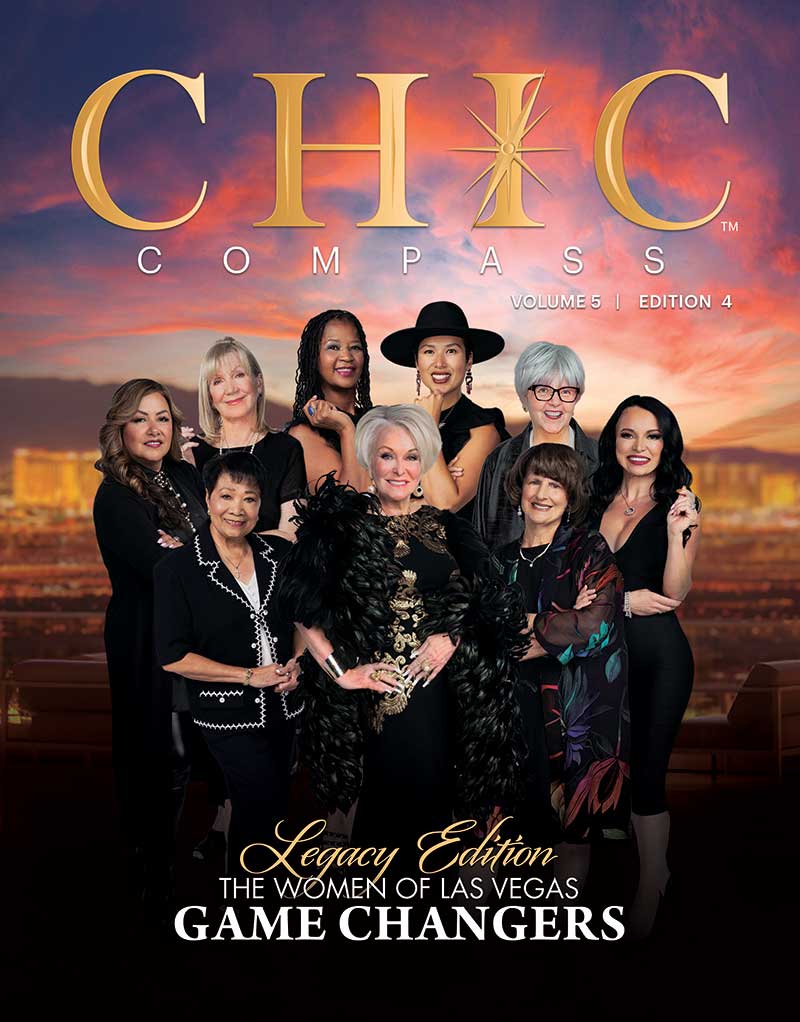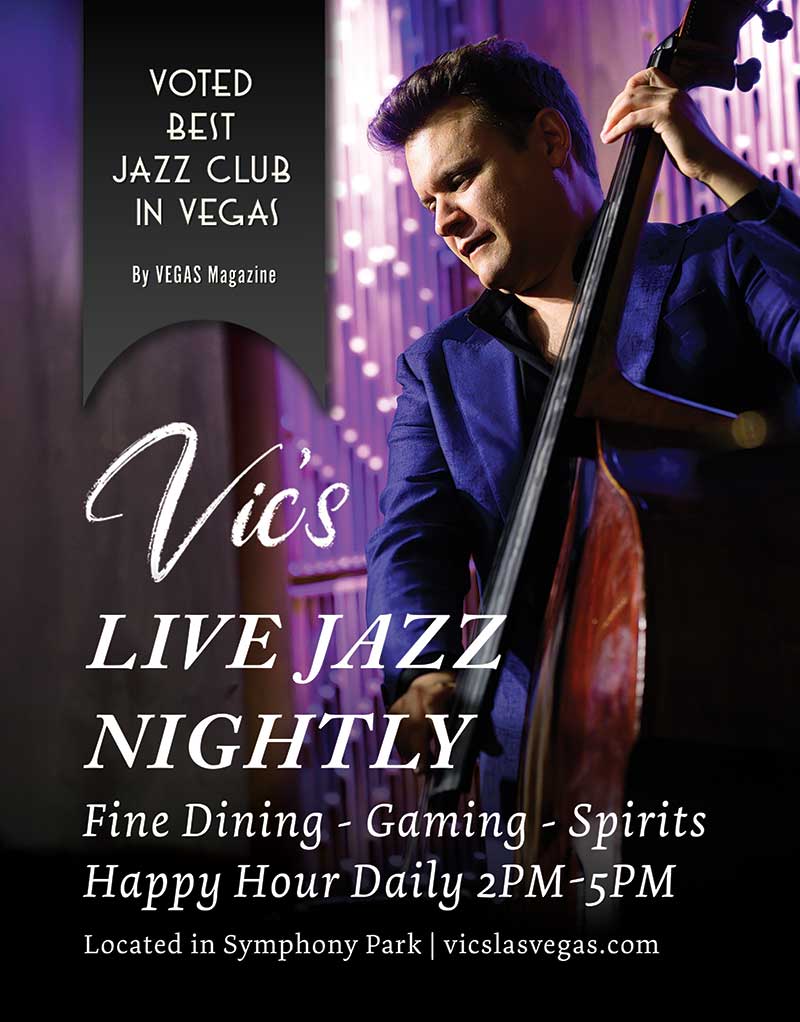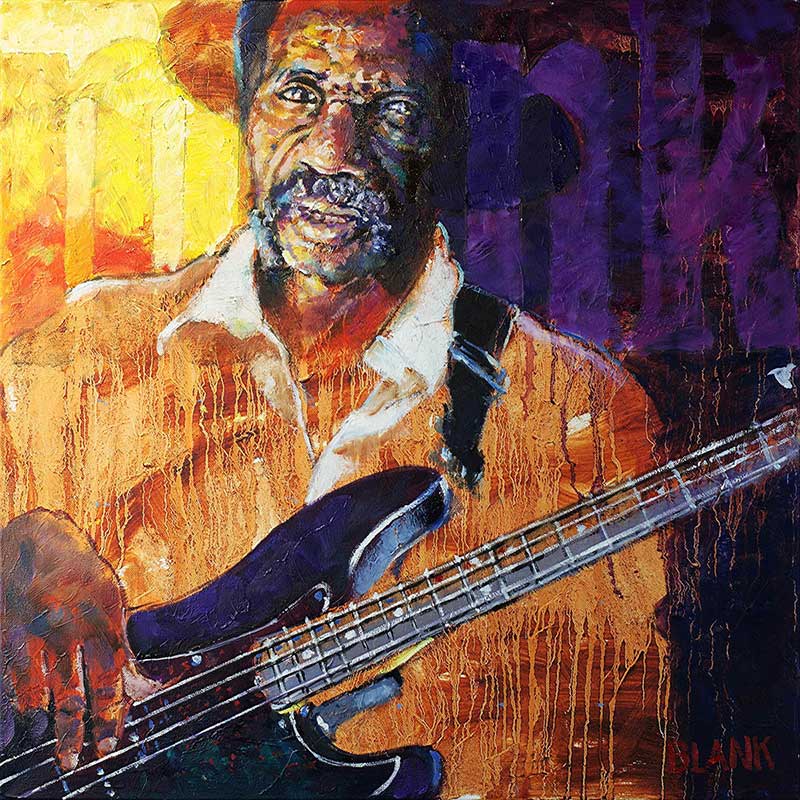
Above: Painting of Monk Montgomery courtesy of artist Jerry Blank
Roots of Jazz
BY KENDALL HARDIN
The Las Vegas Jazz Society (LVJS) – one of Nevada’s oldest cultural nonprofits – is celebrating a long, illustrious history while it reinvents itself with two novel projects for the future.
Today’s hip-hop and rap generations may not even recognize this 48-year-old organization, conceived during the golden era of live music in Vegas. That was a time when every casino on the Strip hired cadres of the most talented instrumentalists and vocalists in the country to wow guests around the clock with elite house bands and stellar lounge acts.
Monk’s Dream
The great jazz bassist and composer Monk Montgomery, the elder brother of jazz guitarist Wes and vibraphonist/pianist Buddy, moved to Las Vegas in 1966. Monk was an early adopter of the Fender Precision Bass invented in 1950.
Upon his arrival, he found the jazz scene sadly lacking, even though the town was teaming with fine musicians lusting to play this kind of music. His dream was to provide more outlets to showcase their music while luring nationally and internationally renowned jazz musicians to major venues on and off the Strip.
By 1975, he had convinced several local musicians, jazz fans, and notable Las Vegas residents to share his dream, and the Las Vegas Jazz Society was formed as a nonprofit cultural organization. That summer, the Society debuted its first concert featuring Joe Williams and the Freddy Hubbard Quintet in the Judy Bayley Theater on the UNLV campus.
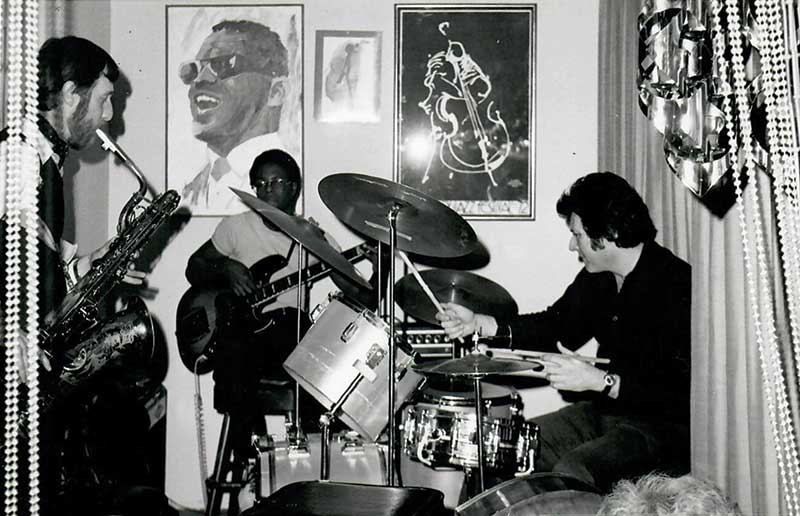
Above: Jam session at Monk Montgomery’s Home in 1980. Photo by Chuck McGuire
In subsequent years, Monk’s dream took shape as major hotels such as the Sands, Stardust, Hacienda, Desert Inn, Landmark, Tropicana, and the Dunes began to headline legendary luminaries who embraced modern American-born jazz on their properties – immortal stars like Dizzy Gillespie, Count Basie, Herbie Hancock, Max Roach, Louis Bellson, Ella Fitzgerald, Sarah Vaughan, and Cal Tjader.
Think Jazz!
A ten-member Board of Directors, consisting of a cross-section of musicians and jazz-loving citizens, guided the Jazz Society. A support team of renowned musicians titled “Jazz Ambassadors at Large” was also assembled to spread the word, the music, and the dream far and wide. Included in this group of Ambassadors were Joe Williams, Eddie “Lockjaw” Davis, Marlena Shaw, James Moody, B.B. King, and Carl Fontana.
The Jazz Society became Monk’s passion. He not only organized and performed in concerts and clubs but also spearheaded a political movement to designate the month of May as “Jazz Month” in the state of Nevada.

Above: Think Jazz! merchandise in the early days of the Jazz Society
In addition, he chaired LVJS board meetings and wrote “Monk’s Corner” feature articles in Think Jazz, the society’s monthly newsletter – while hosting parties and jam sessions in his home. He also anchored a late-night jazz radio broadcast where he played recordings of the genre and interviewed jazz celebrities performing in Las Vegas. Think Jazz was the show’s motto and the model for his life.
During this time, Monk discovered that he had bone cancer. Despite the knowledge of his illness, he never slowed down. He died in Las Vegas on May 20, 1982. Thanks to the Las Vegas Jazz Society, his vision has been kept alive by dedicated individuals and organizations for nearly five decades. Thanks to one dream of one man, America’s unique art form has continued to flourish in Sin City.
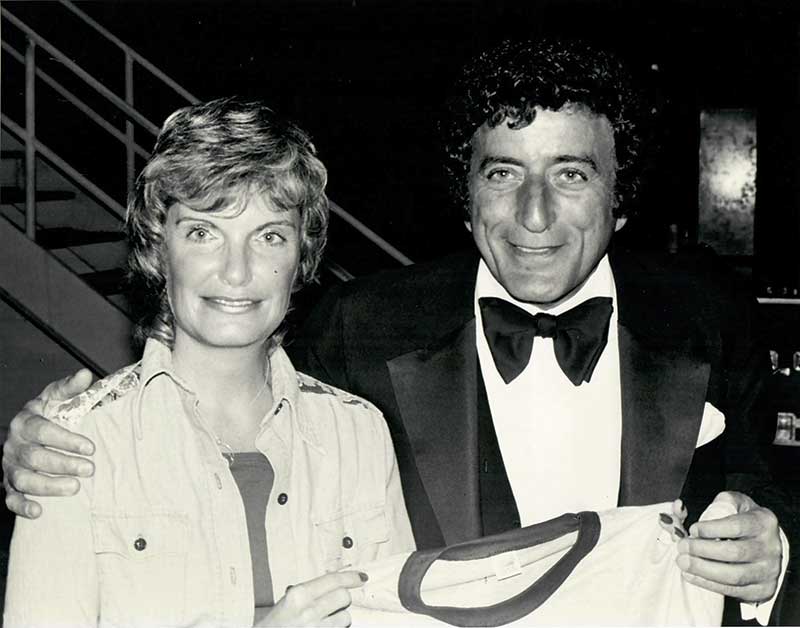
Above: LVJS President Judy Tarte with Tony Bennett
From Past to Present
Changing times require that the Jazz Society keep reinventing itself, just like the art form itself. However, the organization has suffered from many of its founders and most stalwart supporters “aging out.” Just in the last few years, some of Vegas’ finest from the Golden Era – icons like Gus Mancuso, Frank Leone, Vince Falcone, and Carl Saunders – have perished.
“Back in the 60s, the whole town was a family,” recalled Tom Hall, who worked on the Strip for 45 years, with 25 years as lead alto for the Riviera’s House Band. “If you got out of line,” he added, “you were soon sucking sand,” referring to the Mob’s sense of justice in the early days.
The one constant in the Jazz Society’s lifeline is its own “jazz angel,” Judy Tarte – present at the moment of creation in 1976 and today as president of the LVJS Board.
Like her music teacher father in Detroit, she became an avid big band and jazz fan. “As a single mother teaching in Las Vegas, I sought out the Big Band Jazz concerts in Paradise Park and the picnics that the musicians’ wives organized,” recalls Judy.
“I soon learned the place to be was at Musicians Local 369 in the after-hours, when Strip musicians gathered to jam in kicks bands (just for kicks) and share amazing stories from the “road.” The idea of a jazz society was in the air.
“That’s when I met Monk Montgomery, who convinced me to volunteer and join the founding board,” Judy continued. “Everyone loved Monk. He devoted his life to jazz, and had a way of convincing people that they could accomplish things they couldn’t even imagine.”
Judy volunteered to organize hotel reservations for musicians flying in at all hours, as well as advertising sales. “I realized then I was a day person working with night people,” she joked.
It was a glorious time when there were gigs galore for everyone. Thanks to Monk’s efforts, casino marquees started lighting up headliners like Chuck Mangione, Chic Corea, Herbie Mann, and Jean-Luc Ponty. Jazz had finally found its home on the Strip.
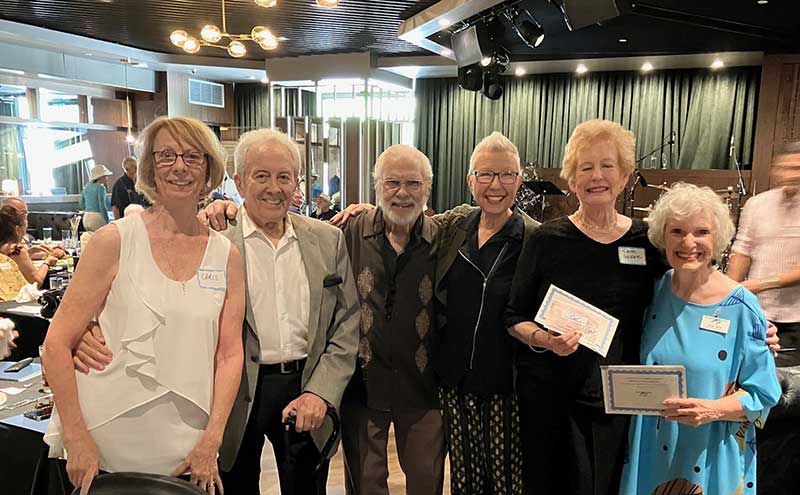
Above from left: LVJS Today – Chris and Greg Blando, Tom Hall, Jodi Warman, Cam Usher and Judy Tarte
Partnering Up!
Judy Tarte followed Monk Montgomery as president of the LVJS and stepped into the leadership role off and on, including the present. “I have the best active board and advisory team I’ve ever worked with,” she proudly boasts. “We remain community-based to support the local clubs and jazz in all its forms.”
New partnerships have shaped today’s Jazz Society. On the second Sunday of the month, LVJS presents Sunday Jazz at the Bootlegger Bistro, highlighting some of the hottest performers in town. October marks the organization’s annual Picnic in the Park at Winchester Cultural Center. The Society counts Lorraine Hunt Bono at the Bootlegger and Irma Varela at Winchester as its many longtime supporters.
Everyone should know about LVJS’s website at lvjs.org. In addition to Jazz Notes and membership information, the Society compiles the most comprehensive week-by-week guide to jam-packed jazz events throughout the Vegas Valley – the top go-to source for music lovers.
The Sideman Story
Unique initiatives are energizing the Las Vegas Jazz Society in the coming year.
Working collaboratively with the Nevada State Museum in Las Vegas, LVJS is turning over all its photos, recordings, memorabilia, and documents to professional archivists to preserve the local history of Las Vegas jazz in one location for posterity.
Over time, the Society envisions that this ongoing collection will culminate in a major exhibition entitled “The Sideman Story,” featuring scores of extraordinary musicians and their contributions to the unique entertainment culture of Las Vegas.
The exhibition will tell the story of the countless men and women who settled in the Valley during the 40s, 50s, and 60s – lured by the promise of a steady gig. Here was the opportunity to escape the Big Band touring life: the one-night gigs, endless hotel rooms, living out of a suitcase, and lonely separation from family and loved ones.
The bustling Sin City offered opportunities for abundant work – even a chance to settle down and buy a home where musicians could raise a family. Sidemen were pioneers of a sort, forming the foundation of what became “Las Vegas, the Entertainment Capital of the World.”
Many of these families are now the bedrock of the Valley, producing a legacy of second and third-generation musicians. Their stories continue.
Music and the Mind
The Society has also connected with the Lou Ruvo Center for Brain Health as a partner in the Center’s “Music and the Mind” program to explore the impact of music on different forms of dementia.
“We’ve lost so many jazz musicians to Alzheimer’s disease,” cited Judy Tarte. “Gus Mancuso was a perfect example of how music eased his dementia. His brain forgot everything except the music he continued to perform in his home until his life ended.
“I don’t know where this project will take us, but we are all thrilled to be part of something that may positively impact generations to come.”
Lend a Hand!
The Las Vegas Jazz Society exists to SUPPORT and co-sponsor professional jazz artists and performances, to PROMOTE up-and-coming young musicians in the community and schools, and to PROVIDE opportunities to those who appreciate such amazing music. In this way, all of us can share a common interest in this uniquely American, constantly evolving art form we call jazz.
- Don’t throw away those vintage photos, programs, and other jazzy memorabilia. Donate them to the Jazz Archives Project by contacting Judy Tarte via email at jazzsocietylasvegas@gmail.com.
- Become a member online at membership@lvjs.org and enjoy discounts on tickets and merchandise, plus member-only perks, knowing you are investing in the extraordinary Las Vegas jazz of today and tomorrow.
- And, perhaps as the perfect grace note, reintroduce Monk Montgomery’s dream to designate the month of May as Jazz Month in Nevada.

